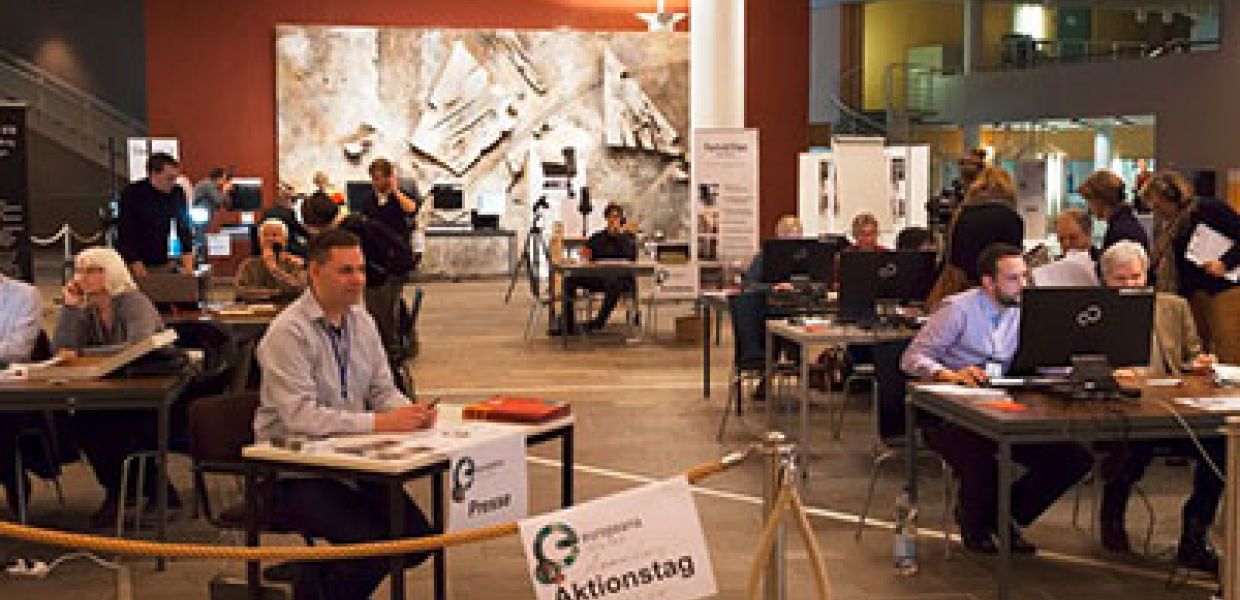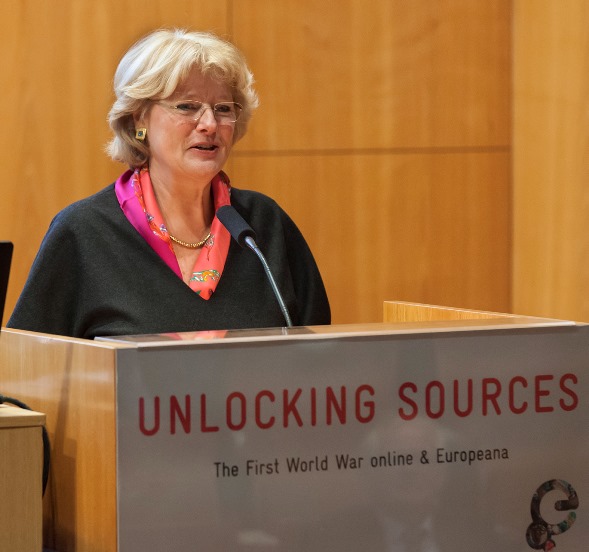Berlin: Europeana 1914-1918

By Jon Purday, Head of Communications at Europeana.
For a German version of this blog, please scroll down.
There was huge media interest in the launch of the new Europeana 1914-1918 site in Berlin on 29 January. All the main German news programmes, including Tagesschau and Tagesthemen, ran features which were seen by more than 12 million people. The national newspapers followed up the next morning, and over the first 48 hours the new site had 70,000 visitors.
The Berlin State Library hosted the launch, and the formal introduction to the site was given by the new Federal Commissioner for Culture and Media, Monika Grütters, who gave a very supportive and thoughtful speech. Ms Grütters said, 'A project such as Europeana 1914-1918 touches a nerve. It illuminates this time of darkness and destruction by giving access to hundreds of thousands of documents and objects from all over Europe - from a private photo to a documentary film shot. [...] Europeana is a great bridge builder. In a wonderful way it is founding connections between cultural institutions across Europe. It is making an important contribution to European cooperation and understanding across borders and the battlelines of history.'

Federal Commissioner for Culture and Media, Monika Grütters
The event also marked the opening of the conference 'Unlocking Sources: the First World War Online', hosted by the Berlin State Library, an opportunity for historians, educators, curators and digital developers to hear about online resources for learning and research into the conflict as the centenary of its outbreak begins.
The Europeana 1914-1918 site brings together three sets of content from 20 countries in Europe – 400,000 items digitised by national libraries as part of Europeana Collections 1914-1918, 660 hours of film digitised by EFG14, and 90,000 images of First World War family papers and memorabilia. This last set of material has primarily been digitised during Europeana’s family history roadshows. These have been taking place around Europe over the past 3 years, and ran in parallel to the conference at the Berlin State Library on 30 and 31 January.
Because of the publicity, the Berlin roadshows – also known as collection days – were very busy: 350 visitors came along and 11,500 digital images were taken. We had great support from the company Image Access who provided Bookeye scanners and other professional equipment, with their operators, on both days. The teams from the State Library, Facts & Files and volunteers from Oxford University did a splendid job of scanning, interviewing and processing the remarkable range of memorabilia that people brought along. The collection days, co-ordinated by Frank Drauschke of Facts and Files in Berlin, were among our most successful ever.
.jpg)
The Europeana 1914-1918 Family History Roadshow gets underway
.jpg)
An album of fundraising ribbons gets some media attention
Europeana 1914-1918 also brings in related information from America, Australia and New Zealand through APIs. Conversely, Europeana’s API, which gives access to the pan-European, openly-licensed dataset of First World War material, is available for organisations or developers to use to incorporate Europeana’s data into their site, web services or apps. Already, a new exhibition, and two sites for learning are being developed using the source material. One, from the British Library, is already live; the other, from the Association of European History Teachers, EUROCLIO, will launch shortly.
Berlin: Europeana 1914-1918
von Jon Purday, Head of Communications, Europeana.
Die Freischaltung der neuen Europeana 1914-1918 Website in Berlin am 29. Januar rief ein beeindruckendes Medienecho hervor. Alle wichtigen deutschen Medien, einschließlich Tagesschau und Tagesthemen, berichteten darüber. Die Fernsehbeiträge wurden von mehr als 12 Millionen Menschen gesehen. Im Laufe der ersten 48 Stunden besuchten 70.000 Internetnutzer die neue Seite.
Die Staatsbibliothek zu Berlin war Gastgeberin der Vorstellung der neuen Website und Prof. Monika Grütters, die neue Beauftragte der Bundesregierung für Kultur und Medien, hielt eine sehr anregende Laudatio.
Frau Grütters sagte: "Ein Projekt wie Europeana 1914-1918 trifft genau diesen Nerv. Es bringt Licht in diese Zeit der Dunkelheit und der Zerstörung, indem es Hunderttausende von Dokumenten und Objekten aus ganz Europa erschließt – vom privaten Erinnerungsfoto bis zur dokumentarischen Filmaufnahme. [...] Die Europeana ist in diesem Sinne eine große Brückenbauerin. Sie stiftet auf wunderbare Art Verbindungen zwischen Kultureinrichtungen in ganz Europa und leistet dabei einen wichtigen Beitrag zur europäischen Zusammenarbeit und Verständigung über Grenzen und über die Gräben der Geschichte hinweg. "

Kulturstaatsministerin Monika Grütters
Die Veranstaltung war gleichzeitig auch der Auftakt der ebenfalls in der Staatsbibliothek stattfindenden Konferenz "Unlocking Sources: Der Erste Weltkrieg online", bei der Historiker, Pädagogen, Kuratoren und digitale Entwickler die Chance hatten, über Online- Ressourcen in Lehre und Forschung zum ersten Weltkrieg zu diskutieren.
Die Europeana 1914-1918 Website vereinigt Materialien aus 20 Ländern Europas, aus drei großen Digitalisierungsprojekten - 400.000 Objekte aus Nationalbibliotheken von Europeana Collections 1914-1918, 660 Stunden digitalisierte Filmaufnahmen von EFG14 und über 90.000 Bilder und Erinnerungsstücke die von Privatpersonen beigetragen wurden. Letztgenanntes Material wurde vor allem während der Europeana Aktionstage digitalisiert. Aktionstage haben in den letzten 3 Jahren in ganz Europa und ebenso parallel zur Konferenz in der Staatsbibliothek zu Berlin am 30. und 31. Januar stattgefunden.
Durch die umfangreiche Berichterstattung waren die Aktionstage sehr gut besucht: Es kamen 350 Besucher und 11.500 digitale Aufnahmen und Scans wurden gemacht. Die Firma ImageAccess unterstützte uns großartig, indem sie mehrere Bookeye Scanner an beiden Tagen zur Verfügung stellte. Die Mitarbeiter der Staatsbibliothek, von Facts & Files und Freiwillige der Universität Oxford haben eine hervorragende Arbeit geleistet, indem sie die mitgebrachten Erinnerungsstücke digitalisiert und mit den Besuchern Interviews geführt haben. Diese Aktionstage, die von Frank Drauschke von Facts & Files aus Berlin koordiniert wurden, gehören zu unseren erfolgreichsten überhaupt.
.jpg)
Startschuss für die Europeana 1914-1918 Aktionstage in der Staatsbibliothek zu Berlin
.jpg)
Ein Album mit Vivat-Bändern bekommt die Aufmerksamkeit der Medien
Europeana 1914-1918 ermöglicht mit Hilfe von APIs auch die Suche nach ähnlichen Daten und Objekten zum Ersten Weltkrieg aus den USA, Australien und Neuseeland. Ebenso ermöglicht die Europeana-API den freien Zugriff auf den gesamteuropäischen Datenbestand zum Ersten Weltkrieg, Organisationen oder Entwickler können die Daten von Europeana für ihre Websites, Webdienste oder Apps verwenden.
Eine neue virtuelle Ausstellung und zwei Lern-Websites wurden bereits mit Hilfe des Quellenmaterials entwickelt. Die Eine, von der British Library, ist bereits online, die andere, von der Vereinigung der europäischen Geschichtslehrer, EUROCLIO, wird in Kürze freigeschaltet.
